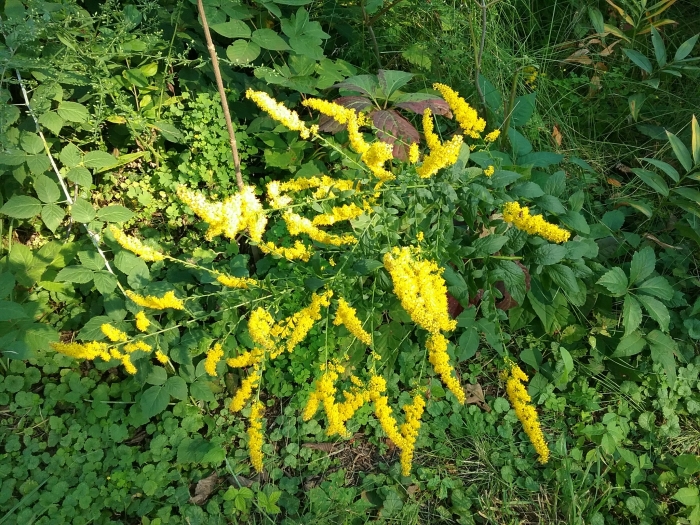Elm-Leaved Goldenrod
(Solidago ulmifolia)
Elm-Leaved Goldenrod (Solidago ulmifolia)
/
/

Mary Crickmore
Public Domain
Image By:
Mary Crickmore
Recorded By:
Copyright:
Public Domain
Copyright Notice:
Photo by: Mary Crickmore | License Type: Public Domain | License URL: http://creativecommons.org/publicdomain/zero/1.0/ | Rights Holder: Mary Crickmore | Publisher: iNaturalist | Date Created: 2021-09-11T10:28:04-07:00 |
















































Estimated Native Range
Summary
Solidago ulmifolia, commonly known as Elm-Leaved Goldenrod, is a deciduous perennial herb native to a variety of habitats including open woodlands, forest edges, and meadows in the Eastern United States. It typically grows up to 120 cm (4 feet) tall and features a woody underground caudex. The plant is characterized by its elm-like leaves and can produce up to 150 small, showy yellow flower heads in a large, open, branching array at the top. The flowering season extends from late summer into fall, providing a late source of nectar for pollinators.
Elm-Leaved Goldenrod is valued for its bright yellow flowers that add color to the garden when many other plants are starting to decline. It is used in naturalistic plantings, borders, and as part of pollinator-friendly gardens. This goldenrod is relatively low maintenance, tolerating a range of soil types, though it prefers medium moisture and good drainage. It thrives in full sun to part shade. While generally not aggressive, it can spread in optimal conditions, so gardeners may need to manage its spread to prevent it from overtaking other plantings. It is not commonly afflicted by serious diseases or pests, making it a resilient choice for many garden settings.CC BY-SA 4.0
Elm-Leaved Goldenrod is valued for its bright yellow flowers that add color to the garden when many other plants are starting to decline. It is used in naturalistic plantings, borders, and as part of pollinator-friendly gardens. This goldenrod is relatively low maintenance, tolerating a range of soil types, though it prefers medium moisture and good drainage. It thrives in full sun to part shade. While generally not aggressive, it can spread in optimal conditions, so gardeners may need to manage its spread to prevent it from overtaking other plantings. It is not commonly afflicted by serious diseases or pests, making it a resilient choice for many garden settings.CC BY-SA 4.0
Plant Description
- Plant Type: Herb
- Height: 1-3 feet
- Width: 1-3 feet
- Growth Rate: Moderate
- Flower Color: Yellow
- Flowering Season: Summer, Fall
- Leaf Retention: Deciduous
Growth Requirements
- Sun: Full Sun, Part Shade
- Water: Medium
- Drainage: Medium
Common Uses
Bee Garden, Bird Garden, Butterfly Garden, Deer Resistant, Drought Tolerant, Hummingbird Garden, Low Maintenance, Rabbit Resistant, Street Planting
Natural Habitat
Open woodlands, forest edges, and meadows in the Eastern United States
Other Names
Common Names: Elmleaf Goldenrod
Scientific Names: Solidago ulmifolia , Solidago helleri , Aster ulmifolius , Asterales ulmifolius
GBIF Accepted Name: Solidago ulmifolia Muhl. ex Willd.